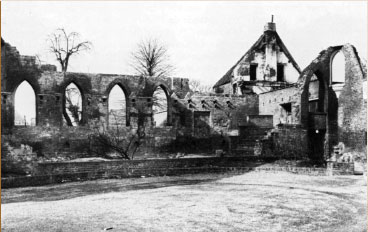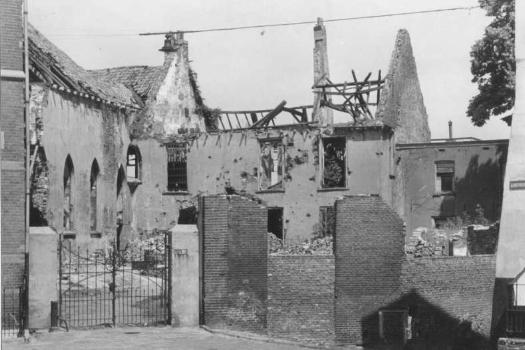Situated in the heart of Nijmegen, but away from the noisy shopping streets, the St. John’s Commandry is a place where people can quietly enjoy good food and delicious drinks. Not a bad use of a monumental building which was built over 800 years ago, to give travelling pilgrims a place to rest and regain their strength. But in the meantime, a lot has happened and the building has been altered countless times:
From a hospital….
The Commandry’s history started in 1196, when Count Alardus and his wife Uda had a hospital (pilgrims’ house) built on this site. In 1214, the building was offered to the Order of Saint John. This was a military religious order, which took part in the crusades and took care of pilgrims. Here they founded a monastery and a pilgrims’ house. The monastery was led by the commandator, hence the name: Commandry of the Order of Saint John the Baptist of the Sacred Hospital of Jerusalem, also known as St. John’s Commandry.
In 1495, the monastery had 11 beds, of which 9 were intended for monks and staff. Therefore, the hospital was probably rather small at that time. However, the attic contained a huge stock of hops. That means that beer was probably already brewed within these walls 500 years ago!
In 1530, Charles V donated the island of Malta to the order. From then on, the order was also called the Order of Malta. This was practical: because the Commandry was now neutral Maltese territory, it was left in peace by the upcoming protestants. The condition was, however, that they would house a protestant preacher. The Order of Saint John agreed, but the pulpit was not yet in place when the Protestants were already chased out of the city, as punishment for the Beeldenstorm, an event during which Catholic art and decoration was destroyed by Protestants. A few sturdy Catholic women dragged the pulpit to De Blauwe Steen (“The Blue Stone”), where the seat was scourged and burned. The Order of St. John remained conspicuously aloof from the disorder.
…from a school, barracks, church…
Then the Order of St. John fell on hard times. They watched helplessly as Spanish soldiers, a new Protestant church and even a butchery took residence in their building. War caused the building to deteriorate more and more. After the last commandator died in 1638, the Commandry was confiscated by the city. It now became a university college, De Kwartierlijke Illustere School (“The Illustrious School of the District”). After the French conquest in 1672, this school already ceased to be and the building became a barracks. After 1686, French Protestants fled to the Netherlands to escape persecution. The Walloon church was allowed to establish itself in the Commandry.
…ruins, tavern, student residence and museum…

The bombardment in 1944 spelled the end of the Walloon church. The building was heavily damaged and further deteriorated in the following years. To save the building from complete demolition, Nijmegen resident J. Th. van Weel started Het Wijnhuis (“The Winehouse”) in the ruins in 1952, which soon became a popular venue. In 1962, the building acquired a new purpose:

it would become the club of student association Roland. In 1969, the plans for renovation, which had been put on hold, were resumed. However, it turned out that the original plans could no longer be achieved. The municipal government assumed responsibility over the restoration, in order to turn the building into a museum. Actually, the restoration was more of a reconstruction of the Commandry the way it was before the Walloon church made it its home. Only the cellars, the tower and the west-wing have remained standing. The main gate, constructed in 1655, can still be seen today. Not in the Commandry, but in the town hall, where it has been moved in 1894. In 1998, the museum relocated to Kelfkensbos, and is now known as the Valkhof Museum.
…until the present.
Now the Commandry has become a sanctuary for the true Epicurean, where you can taste countless products, all of them artisanally crafted by the various companies that reside within these walls. For instance, during tastings you can relish the delicacies from the kitchen of Restaurant De Hemel, beers from Brouwerij De Hemel, coffee from Koffiebranderij de Hemel… However, you can also just simply enjoy the sunlight on the most beautiful terrace of Nijmegen. Would you like to know more? Read this article, written in 1958!
